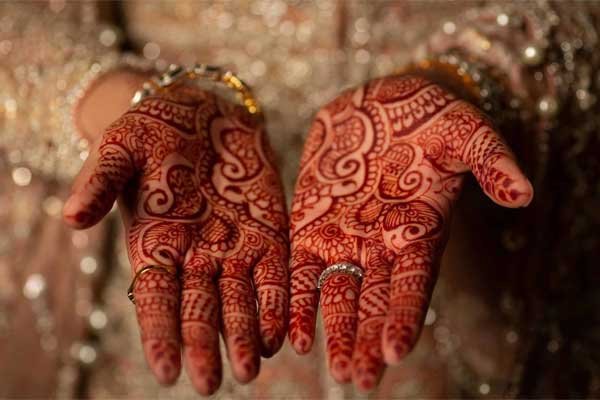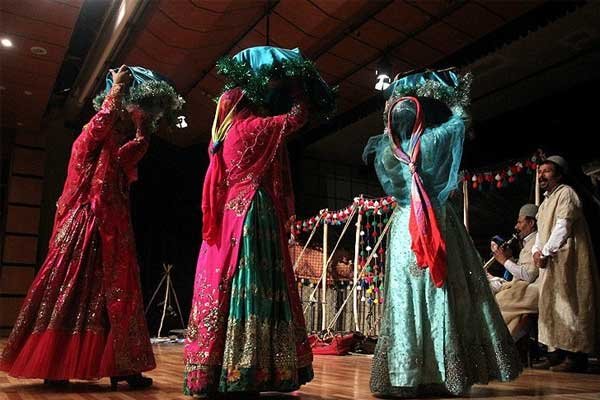“Hanabandan” is a cultural ceremony in Iran that is held on specific occasions. This ceremony is commonly held in most Iranian and Turkish communities, especially in villages and small towns. “Hanabandan” typically refers to a collective gathering where people are invited from near and far to the home or a specific location hosted by a family or group of individuals. It serves as an opportunity to strengthen traditional singing and music performances, and local shows, poetry recitals, and storytelling may also take place. Culturally and socially, this ceremony plays a significant role in preserving and promoting local values and traditions, contributing to social cohesion.
“Hanabandan” is typically held one night before a wedding. It has various customs and holds special importance among certain ethnic groups. Due to its unique nature, “Hanabandan” often surpasses the wedding night itself in terms of enjoyment for the bride, groom, and guests. Generally, in this ceremony, the groom’s family prepares and decorates the “Henna” in their home and brings it to the bride’s home. “Hanabandan” is held at the bride’s house, and the cost of hosting the guests is borne by the bride’s father.
“Hanabandan” is a ceremony held after the engagement and usually one day before the wedding celebration. It is essentially a farewell to the bride, marking the last night the bride spends in her father’s house. “Hanabandan” involves the preparation and application of “Henna” (a symbol of happiness, joy, and well-being in various cultures) by the groom and his family at his home, traditionally taking it to the bride’s home during a ceremony marked by celebration. Sisters or female relatives of the bride are responsible for applying “Henna” on the bride’s hands, while the groom’s brother or male relatives handle the groom’s “Henna.”
Today, due to the glamour and luxury associated with wedding ceremonies, this celebration is usually not held. Instead, they contribute significantly to the wedding expenses by presenting gifts (often monetary). In this ceremony, guests rotate a container containing “Henna,” taking a portion of it and placing their gifts beside the “Henna” container, concluding this stage of the “Hanabandan” ceremony. Subsequently, the main part of the ceremony begins with the decoration of the bride’s hands and feet. These gifts are sometimes given directly to the bride’s father to contribute to the bride’s dowry.
How is “Hanabandan” celebrated in Turkey?
“Hanabandan” in Turkey, known as “Kina Gecesi,” is one of the essential ceremonies in preparing for a wedding in Turkish culture. This ceremony is usually held one to two nights before the wedding celebration. In this ceremony, the bride and groom, along with their friends and families, gather at the bride’s home or a special venue.
The “Kina Gecesi” ceremony, meaning “Henna Night,” serves as one of the last pre-wedding rituals. During this ceremony, a woman representing the bride’s family slowly places a crown made of roses and carnations on the bride’s head. Then, the present friends and families take turns placing the crown on the bride’s head. This act symbolizes the love and support of family and friends for the bride and groom.
Additionally, in this ceremony, women and girls present apply “Henna” on the bride’s hands and feet. “Henna” is an herbal substance colored red and applied on the hands and feet, symbolizing new life and love at the beginning of the marriage journey.
Music, food, and wine are also significant parts of this ceremony, and wedding guests spend enjoyable times together. This ceremony is considered an opportunity for family and friends to get to know each other better and foster social cohesion.
How is the attire and makeup of the bride during the “Hanabandan” ceremony in Turkey?
In the traditional Turkish “Hanabandan” ceremony, brides often opt for attire that reflects the rich cultural heritage of the region. These garments, steeped in tradition, symbolize the significance of the occasion and are carefully selected to enhance the bride’s beauty and elegance. Red is a popular choice of color for the bride’s attire, symbolizing love and joy, and it is often adorned with intricate embroidery and traditional motifs. The dress is meticulously crafted, with attention to detail evident in every stitch, reflecting the craftsmanship and artistry of Turkish bridal fashion.
In addition to the attire, makeup plays a crucial role in completing the bride’s look for the “Hanabandan” ceremony. Brides typically opt for makeup that accentuates their features and enhances their natural beauty while adhering to traditional aesthetics. Special attention is paid to eye and lip makeup, with vibrant and cheerful hues often chosen to complement the celebratory atmosphere of the occasion. Hairstyles may also feature decorative elements such as ornate hairpins or floral arrangements, adding a touch of elegance and sophistication to the bride’s overall appearance.
Overall, the attire and makeup of the bride during the “Hanabandan” ceremony in Turkey reflect not only individual style preferences but also cultural heritage and societal norms. Through their choice of attire and makeup, brides honor tradition while also expressing their unique personalities and celebrating the joyous occasion of their wedding day. The meticulous attention to detail in both attire and makeup underscores the significance of this cultural celebration and contributes to the overall beauty and splendor of the event.
Hanabandan Attire
Brides in the Turkish “Hanabandan” ceremony usually opt for traditional Turkish attire, which may include a specially designed and beautiful bridal gown. The evening dress for “Hanabandan” is usually prepared in various colors, such as red, gold, silver, green, blue, pink, and purple. Red, symbolizing love and joy, is highly favored and often handcrafted with special decorations, including beautiful embroidery and traditional motifs.
Jewelry
Brides may accessorize with precious jewelry such as necklaces, earrings, rings, and bracelets. These jewelry pieces are typically made of gold or silver and adorned with precious stones.
Makeup
The makeup of brides during the “Hanabandan” ceremony in Turkey is usually very precise and beautiful. Special attention is paid to eye and lip makeup, often done with bright lipsticks. Additionally, decorative hair accessories are commonly used to adorn the bride’s hair.
Henna and Body Paintings
A significant feature of the “Hanabandan” ceremony in Turkey is the use of henna for body painting, sometimes also for the groom. These paintings are done in various shapes and designs, primarily with white or red henna. These paintings are considered symbols of love and happiness in the new life of the bride and groom.
The attire and makeup of the bride during the “Hanabandan” ceremony in Turkey are of great importance, and brides usually pay attention to the smallest details to shine in this ceremony. If you intend to hold a traditional “Hanabandan” ceremony, Ramarossi Consultants have the best recommendations for you.
Conclusion
In conclusion, the “Hanabandan” ceremony in Turkey holds significant cultural and traditional importance, particularly for brides. The attire and makeup of the bride during this ceremony are carefully chosen to reflect the cultural heritage and symbolize love, joy, and the beginning of a new life. With beautiful red-colored outfits, intricate jewelry, meticulous makeup, and traditional henna body paintings, brides shine brightly during this auspicious occasion. The attention to detail in their attire and makeup highlights the significance of the “Hanabandan” ceremony as a cherished part of Turkish wedding traditions. Whether opting for a traditional or modern approach, brides strive to make this ceremony memorable and meaningful, symbolizing the celebration of love and unity with their families and communities.
FAQs
What is the significance of the “Hanabandan” ceremony in Turkish culture?
The “Hanabandan” ceremony is a pre-wedding tradition in Turkish culture, symbolizing the farewell to the bride’s parental home and the beginning of her new life with her groom. It serves as a celebration of love, unity, and cultural heritage.
How do brides typically dress and adorn themselves during the “Hanabandan” ceremony?
Brides often wear traditional Turkish attire, which includes intricately designed dresses in various colors such as red, gold, silver, green, blue, pink, and purple. These dresses are often handcrafted and embellished with special adornments like beautiful embroidery and traditional motifs.
What traditional elements are incorporated into the attire and makeup of brides during this ceremony?
Brides adorn themselves with precious jewelry such as necklaces, bracelets, earrings, and rings made of gold or silver, often adorned with precious gemstones. Their makeup is meticulously done, with particular attention to eye and lip makeup, usually using vibrant colors to enhance their beauty.
Are there specific colors or styles associated with the attire worn by brides during the “Hanabandan” ceremony?
Red is a popular color for brides during the “Hanabandan” ceremony, symbolizing love and joy. However, brides may also opt for other colors such as gold, silver, or pastels, depending on personal preference and regional customs.
How does the “Hanabandan” ceremony contribute to the overall celebration of love and unity within Turkish communities?
The “Hanabandan” ceremony brings together family and friends to celebrate the upcoming wedding, fostering a sense of community and togetherness. It serves as a joyous occasion where loved ones gather to bless the bride and groom as they embark on their journey together, strengthening familial bonds and cultural traditions.


